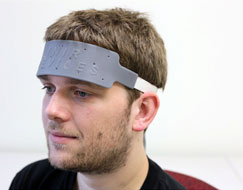Eat Your Pizza at the Table: Nasser Advocates for Naturalistic Settings in Research
October 1, 2013
 How would you like to eat your meals lying on your back, in a metal tube, surrounded by a symphony of strange noises and goggled researchers? This is what it would be like to eat dinner inside of a functional MRI instrument. Jennifer Nasser, PhD, an associate professor of Nutrition Sciences at the Drexel College of Nursing and Health Professions, is a pioneer in developing research methodologies around new technologies that take eaters out of tubes and back to the table.
How would you like to eat your meals lying on your back, in a metal tube, surrounded by a symphony of strange noises and goggled researchers? This is what it would be like to eat dinner inside of a functional MRI instrument. Jennifer Nasser, PhD, an associate professor of Nutrition Sciences at the Drexel College of Nursing and Health Professions, is a pioneer in developing research methodologies around new technologies that take eaters out of tubes and back to the table.
She used two technologies- electroretinography and functional infrared spectroscopy- in her recent studies. “I am excited about them because they allow us to study people’s brain response to food as they eat in a natural type of setting.” In the case of electroretinography, study participants sat upright as they chewed delectable bites of brownies. With functional near infrared spectroscopy, or fNIR, participants wore a headband device while sitting at a table eating pizza. As both technologies improve while testing continues, it may be possible to bring these two tools into the places of people’s eating such as to their homes or to restaurants. For now, Nasser constructs as naturalistic a setting for her research as possible within the laboratory.
In a pilot study she is conducting with fNIR, Nasser invites participants to sit down at a table and eat as much pizza as they want. “They’re sitting upright, they’re using utensils or their hands, and they are chewing as fast or as slowly as they want to chew,” she explained. In essence, the study encourages participants to eat pizza the way they truly would eat pizza. This is opposed to studies conducted by other researchers using functional MRI technology, where researchers showed pictures of food to participants inside of the MRI instrument or dropped tasty liquids into their mouths. “Although the technique has provided us with some very important information, that’s really not naturalistic,” Nasser said.
The fNIR headband allows Nasser to see just a few centimeters deep so that she can watch what is happening in the executive center of the brain. The instrument is intended to show her what a participant’s brain is doing when it says I want to eat! as well as what it is doing when it says I don’t want to eat this anymore. The different functions of the executive center are inhibitory and reward-oriented. The brain’s executive center effectively has a traffic light with a function that says go and one that says stop. Researchers want to know if there is a difference in response from the same food stimulus between people with overeating problems and those without. Nasser uses the analogy of a car: “If you’re coming down a hill, are you going too fast because the breaks don’t work or because the gas pedal is stuck? Or are they both going at once?” fNIR may help researchers understand why some of us overeat.
“It’s good to study in a naturalistic setting in this case, because it’s not just the need for food that drives us to eat,” she said. Most of us no longer distinguish between hunger, which is a physiological need, and desire. “People think they are one in the same but they’re not.”
Perhaps one of the reasons hunger and desire can be difficult to discern is because our brain loves to eat. When we eat, the brain releases a feel-good hormone called dopamine. Nasser was looking for a simple way to estimate how much dopamine a person’s brain puts out when they are exposed to a highly palatable food. She found it in electroretinography.
“Everyone told me that the dopamine system in the eye isn’t connected to the one in the brain,” Nasser said. “That is why I was very excited and surprised to get the results that I did.” While her study participants sat upright in an opthamologist’s chair, she fed them pieces of chocolate brownies. They chewed and swallowed at their own pace, and an eye doctor measured dopamine signals with a light through their dilated eyes. This technology is only getting better. Nasser was invited to visit the factory where the electroretinography instrument is made. The company has developed a new, less invasive instrument that does not require dilation or the application of a contact lens, and Nasser has been asked to evaluate this instrument. She projects that the project will begin in 2014, after Institutional Review Board approval is obtained.
“The whole approach to research that I take is trying to see if we can get some very objective, pharmacological data in a more naturalistic approach with humans,” she stated. “To move forward, in my opinion, we need to go from the strictly very rigid basic science methodologies and bring the methods to where people really are. There has to be an in-between.” Nasser’s two recent explorations with fNIR and electroretinography are just that. In the future, she expects to see these tools moving even closer toward the most naturalistic settings possible.